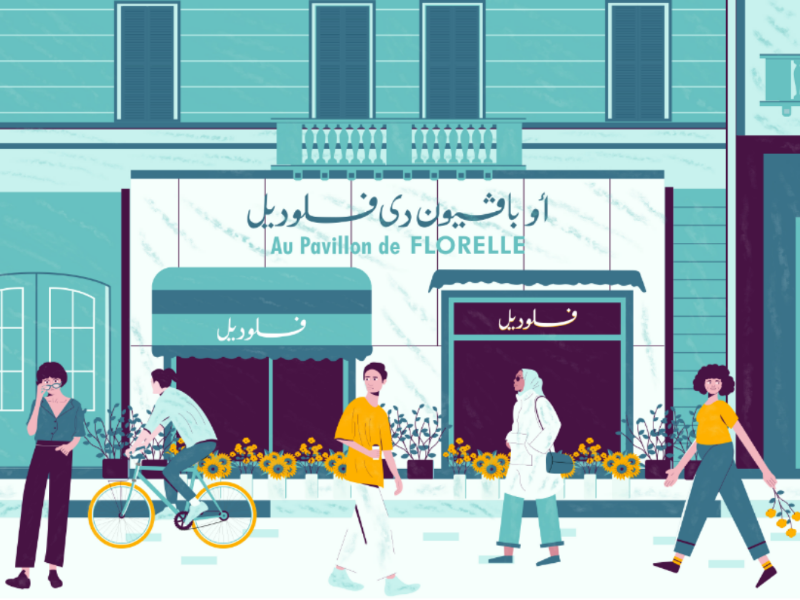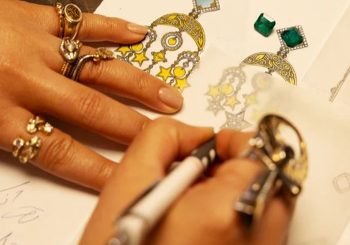Alexandria’s Greek heritage dates back to the 4th century BC, when it was founded by Alexander the Great during his conquest of the First Persian Empire. It is against this historical backdrop that much of Alexandria’s character was formed, evolving from an Egyptian village in ancient times, to the Pearl of the Mediterranean.
This origin story is also what sets Alexandria apart from other Egyptian cities whose indigenous histories are less obscure and aren’t entirely defined by imperial civilizations. This history not only lives on through exalted monuments like Bibliotheca Alexandrina, the catacombs of Kom Al Shuqafa, and Alexander the Great’s elusive tomb, it has also made its mark across Alexandria’s urban landscape. It is emblazoned on the city’s storefronts.
One artist working to highlight the Greek-Egyptian community’s contributions to life in Alexandria is Mahmoud Amin. Earlier this year, the 26-year-old illustrator and animator released a series of artworks highlighting, documenting and rendering Greek-owned businesses that have defined Alexandrian life for well over a century.
“This [project] started because I wanted to render a more precise portrait of Alexandria. My main concept was Greek places built in [the early 1900s],” the Alexandrian artist tells Egyptian Streets. “The Greek population in Alexandria used to number [around] 125,000 people, [working] across different industries. They were very much integrated within Alexandria’s culture and social fabric.”
View this post on Instagram
“Trianon” 📍 محطة الرمل الاسكندريه مقهى تريانون اليوناني أسس عام 1905 الصورة الاصلية ل @kokillennium
Depicting restaurants, like Délices and Trianon, that have defined Alexandria’s dining scene for generations; Au Pavillion de Florelle, Egypt’s oldest flower shop; and Sofiano Poulo, one of Alexandria’s oldest coffee stores, Amin’s illustrations reimagine Alexandria during its cosmopolitan heyday, all while incorporating elements of modern Egyptian life.
“These places evoke good feelings and memories for anyone, Alexandrian or otherwise … they are remembered and cherished by all people for the good times they may have had there, whether you are 80 or 20. Everyone has a connection to these places and that is what I wanted to convey,” Amin explains. “I got feedback from people sharing it, people in the diaspora remembering certain moments and memories, mentioning their friends, people from outside Alexandria expressing their desire to visit, etc.”
View this post on Instagram
“Sofiano Poulo” 1908 Saad zaghlool St.Alexandria أقدم مطحن للبن بالإسكندرية.
Egypt’s Greek community thrived between the time following Alexander the Great’s death and the fall of the monarchy in 1952. It was in the aftermath of Egypt’s nationalist movement that many communities faced increasing hostility and this inevitably affected Greek-Egyptians whose exodus was prompted by late Egyptian President Gamal Abdul Nasser’s policies.
Amin’s series comes at a time when Egyptians are once again strewn between the past and the present, as voices and ideologies clash in the ever-growing and never-ending debate about Egypt’s identity.
View this post on Instagram
“Au Pavillon de Florelle” 📍 Fouad St. Alexandria أقدم محل لبيع الورد في مصر.
For Amin, this project was an effort to preserve this history and make it more accessible to younger Egyptians and Alexandrians who may be unaware of the Greek origin stories behind these heritage restaurants and stores. But as he set out to illustrate the utopian city of his dreams: true to its foundation, resilient enough to stand the test of time and welcoming to all, Amin’s Alexandria had no room for urban decay.
“I am [always] trying to find anything that people are neglecting or that might be endangered [and] to present these things the way the community had intended, so to me it is important to document and beautify them,” he says. “There are around 15 [other] Greek-owned stores [in Alexandria] that have lost their character entirely, they now have new storefronts with very garish colors … to me, documenting these things and highlighting them as Alexandria’s heart and soul is the real deal because you can’t change it to something ugly just to keep up with the times.”







Comments (2)
[…] In Photos: The Digital Artist Reimagining Alexandria’s Greek Heritage […]
[…] In Photos: The Digital Artist Reimagining Alexandria’s Greek Heritage […]